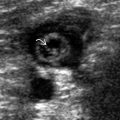GROSS ANATOMY
Overview
- •
Body (corpus) : Upper 2/3 of uterus
- ○
Fundus: Superior to ostia of fallopian tubes
- ○
- •
Cervix : Lower 1/3 of uterus
- ○
Isthmus: Junction of body and cervix
- ○
- •
Parametrium : Tissue immediately surrounding uterus
- •
Myometrium : Smooth muscle forming bulk of uterus
- •
Endometrium : Composed of 2 layers
- ○
Stratum basalis attached to myometrium, does not change
- ○
Stratum functionalis: Thicker, varies with cycle
- ○
- •
Uterus is extraperitoneal in midline of true pelvis
- •
Uterine position
- ○
Flexion is axis of uterine body relative to cervix
- ○
Version is axis of cervix relative to vagina
- ○
Anteversion ± anteflexion is most common
- ○
- •
Peritoneum extends over bladder dome anteriorly and rectum posteriorly
- ○
Vesicouterine pouch (anterior cul-de-sac) : Anterior recess between uterus and bladder
- ○
Rectouterine pouch of Douglas (posterior cul-de-sac) : Posterior recess between vaginal fornix and rectum; most dependent portion of peritoneum in female pelvis
- ○
- •
Supporting ligaments
- ○
Broad ligaments: Extend laterally to pelvic wall and form supporting mesentery for uterus
- ○
Round ligaments: Arise from uterine cornu and course through inguinal canal to insert on labia majora
- ○
Uterosacral ligaments (posteriorly), cardinal ligaments (laterally), and vesicouterine ligaments (anteriorly) form from connective tissue thickening by cervix
- ○
- •
Fallopian tubes connect uterus to peritoneal cavity
- ○
4 segments: Interstitial (portion going through myometrium at cornua), isthmus, ampulla, infundibulum
- ○
- •
Arteries : Dual blood supply
- ○
Uterine artery (UA) arises from internal iliac artery, anastomoses with ovarian artery
- –
UA crosses over the ureter and enters uterus just above cervix
- –
- ○
Arcuate arteries arise from UAs; seen in outer 1/3 of myometrium → radial arteries → spiral arteries (endometrium)
- ○
Uterine Variations With Age
- •
Neonatal: Prominent size secondary to effects of residual maternal hormone stimulation
- •
Infantile: Corpus < cervix (1:2)
- •
Prepubertal: Corpus = cervix (1:1)
- •
Reproductive: Corpus > cervix (2:1)
- ○
7.5-9.0 cm (length); 4.5-6.0 cm (width); 2.5-4.0 cm (thickness)
- ○
- •
Postmenopausal: Overall reduction in size, similar to prepubertal uterus
IMAGING ANATOMY
Myometrium
- •
Inner layer (junctional zone): Thin and hypoechoic, < 12 mm
- •
Middle layer: Thick, homogeneously echogenic
- •
Outer layer: Thin, hypoechoic layer peripheral to arcuate vessels
Endometrium
- •
Proliferative phase (follicular phase of ovary)
- ○
Cessation of menses to ovulation (up to day 14)
- ○
Estrogen induces proliferation of functionalis layer
- ○
Early: Thin, single echogenic line
- ○
Progressive hypoechoic thickening (4-8 mm), classic trilaminar appearance
- ○
- •
Secretoryphase (luteal phase of ovary)
- ○
Ovulation to beginning of menstrual phase (days 14-28)
- ○
Increased echogenicity and progressive thickening up to 16 mm
- ○
- •
Menstrual phase
- ○
Early: Cystic areas within echogenic endometrium indicating endometrial breakdown
- ○
Progressive heterogeneity with mixed cystic (blood) and hyperechoic (clot or sloughed endometrium) regions
- ○
Imaging Recommendations
- •
Start with transabdominal exam, typically using curved low-frequency transducer
- ○
Gives “lay of the land”
- –
Large lesions, particularly exophytic fibroids, may be much better seen transabdominally
- –
- ○
Bladder should be partially full to push small bowel away and create an acoustic window
- ○
- •
With rare exception (young virginal females), transvaginal exam should be performed for more detail
- ○
Sweep completely through uterus in both longitudinal and transverse planes
- ○
Angle probe posteriorly to evaluate cul-de-sac
- –
Most dependent portion so free fluid and other peritoneal pathology implants in this area
- –
- ○
Gently push on probe to show uterus slides easily over bowel ( sliding sign )
- –
Adhesions (e.g., endometriosis) causes organs to be fixed
- –
- ○
- •
Measure uterus in all 3 dimensions and document all myometrial lesions
- •
Entire length of endometrium needs to be evaluated in sagittal (longitudinal) plane
- ○
Measure thickest point perpendicular to endometrial stripe
- ○
If fluid is in the canal, measure each side separately and add measurements together
- ○
- •
Color and pulsed-wave Doppler should be performed on any suspicious lesions
- •
3D ultrasound additive in many cases, particularly müllerian duct (duplication) anomalies and intrauterine device evaluation
- ○
3D volume data sets are acquired and can be manipulated to show optimal projection
- ○
May also slice through data set creating individual images similar to CT
- ○
Perform at beginning of transvaginal scan before bladder starts to refill
- ○
- •
Sonohysterography, with infusion of saline into endometrial cavity, may be used to evaluate endometrial pathology
- ○
Polyps vs. submucosal fibroid, hyperplasia, carcinoma
- ○
UTERUS










